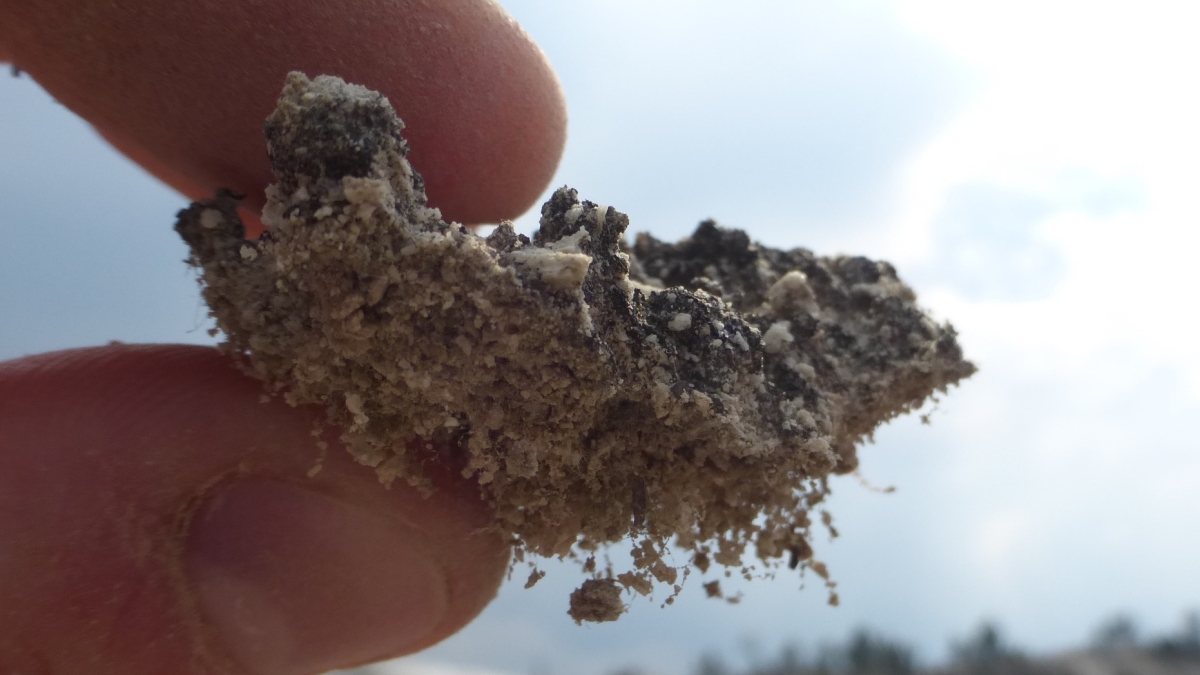ASU research team digs up the dirt on microscopic biodiversity

Scientists have long known that there are thousands of bacteria species in soil samples this size, but they did not begin to understand their roles until recently. An ASU research team has discovered that the bacteria produce hundreds of metabolic compounds, linking the species together and providing clues for their function in the environment.
Photo by: Sergio Velasco Ayuso
A team of researchers from Arizona State University and Lawrence Berkeley National Lab has discovered that thousands of bacteria living in soil are connected by a complex metabolic relationship. Thanks to new analytical technology and the help of undergraduate students, the team dug deeper into compounds created by the microbial life living in the Earth’s crust.
Although scientists have known about the incredible biodiversity in soil for decades, there was no clear cause for the biodiversity or its role in ecology. According to Ferran Garcia-Pichel, ASU School of Life Sciences professor, understanding that role could be critical to maintaining ecological stability.
“One of ecology’s major tenets is diversity begets stability, but scientists don’t know if that saying holds true with microbiology,” Garcia-Pichel said. “If we don’t understand what the role is, how can we predict what’s going to happen with global change or pollution? Do we have to worry about it?”
Modern advances in the field of exometabolomics — the study of how cells change their environments — allowed the research team to map the connections between the hundreds of metabolic compounds created by seven bacterial species. The samples used for this study represent only a small portion of the thousands of bacterial species living in soil.
A paper describing the discovery appears Tuesday in the journal Nature Communications.
Garcia-Pichel said that analyzing the food web created by these metabolic compounds could provide the answers environmental microbiologists have been seeking for years. He added, though, that the next step also involves seeing what happens when that food-web is manipulated.
“What happens if you push these relationships in certain directions, like raising the temperature to simulate global warming,” Garcia-Pichel said. “Do some of them break? How much does it take for the whole system to collapse?”
Once they answer those questions, scientists may understand how microbial biodiversity helps the environment and also how to protect it from serious environmental changes.
School of Life Sciences professor Hinsby Cadillo-Quiroz, another faculty member involved in the project, said the research couldn’t have been done without the help of ASU students.
“Microbial diversity and interactions are vast, and the number of interested undergraduates is vast also,” Cadillo-Quiroz said. “So pairing both can make a big difference on what is achieved by a project and on the education of the achievers. The students were truly a cornerstone to this research.”
Through the “Microbial Education and Teaching Out-Reach at ASU” program, undergraduates isolated more than 700 microbes in soil samples from the American Southwest. This collection helped form the basis of the project’s most recent paper and was even the subject of its own publication in 2014. Students also conducted a number of experiments that contributed to the most recent article under the supervision of ASU faculty and post-doctoral researchers with the Lawrence Berkeley National Lab.
According to Cadillo-Quiroz, also a researcher with the ASU Biodesign Institute, the students claim to have learned more during one semester of research than in most of their classes — and not just in terms of microbiology. Students also learned how to work in or lead a research team of diverse peers.
“It is critical to involve undergraduates in research,” Cadillo-Quiroz said. “Not just because it gives the right perspective to those wishing to have a graduate-studies career, but because involving undergraduates enriches the life of the project and the lives of the students regardless of the professional path they may choose.”
Trent Northen, adjunct faculty member with ASU School of Life Sciences and with the Lawrence Berkeley National Lab, directed this project. Additional collaborators included researchers with Lawrence Berkeley National Laboratory and VU Amsterdam.
This research was funded through the Lawrence Berkeley National Laboratory supported by the U.S. Department of Energy Office of Science and U.S. Department of Energy Office of Science, Office of Biological and Environmental Research Early Career Program #DE-AC02-05CH11231.
More Science and technology

Cracking the code of online computer science clubs
Experts believe that involvement in college clubs and organizations increases student retention and helps learners build valuable…
Consortium for Science, Policy & Outcomes celebrates 25 years
For Arizona State University's Consortium for Science, Policy & Outcomes (CSPO), recognizing the past is just as important as…

Hacking satellites to fix our oceans and shoot for the stars
By Preesha KumarFrom memory foam mattresses to the camera and GPS navigation on our phones, technology that was developed for…